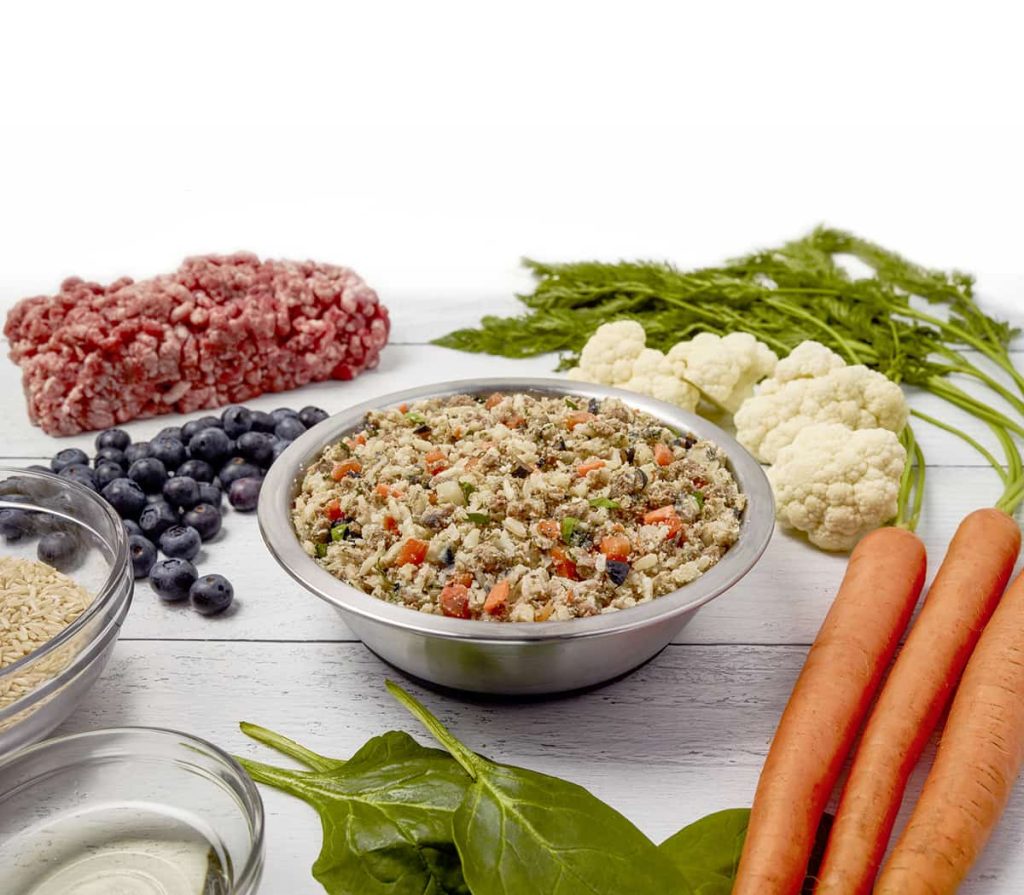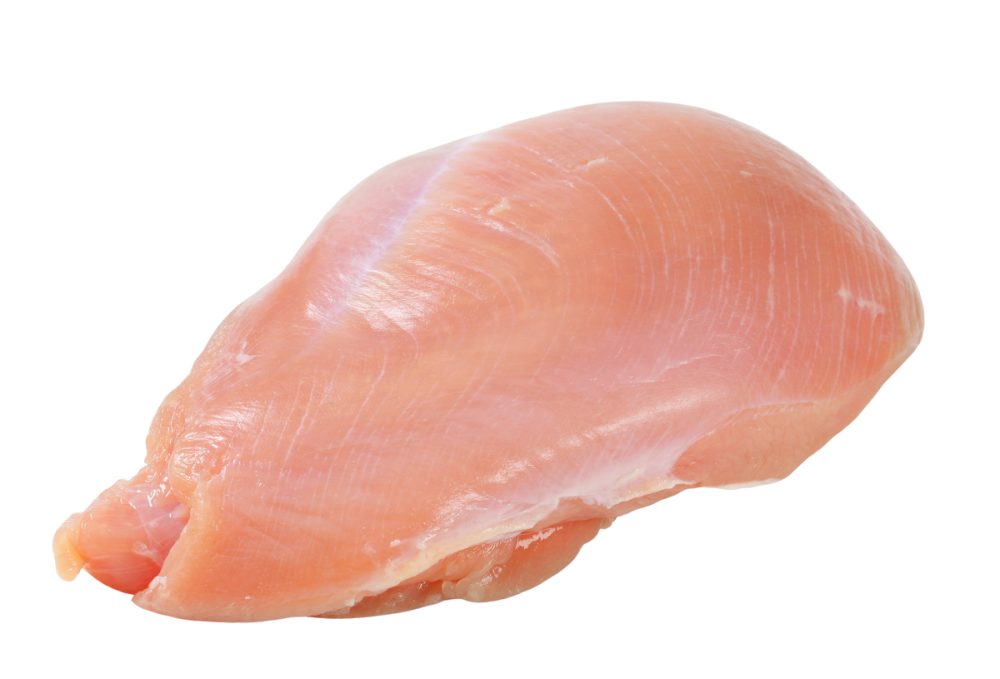It’s true. Dogs can be allergic to chicken. According to veterinarian Dr. Linda Simon, MVB MRCVS, “Chicken is one of the most common food allergies in dogs, alongside beef, wheat, dairy, peas and soya.”
Yet, it can be confusing because veterinarians often recommend the bland chicken and rice diet to pooches with upset tummies. However, if your dog has frequent gastrointestinal problems, respiratory issues, or skin conditions, food allergies could be the cause.
How Food Allergies Work
An allergic reaction to chicken or other food is a breakdown in your dog’s immune system. It might sound odd, but allergens overstimulate the immune system, so it goes into overdrive and treats otherwise neutral substances like dangerous invaders.
Imagine a medieval castle, and the army inside starts preparing for a battle when they see others approaching. The incoming group is friend, not foe, yet the army inside doesn’t realize it.
This is how the allergic response works. It’s a miscommunication in the body, yet the allergic reaction can range from mild to life-threatening. Of course, the reactions differ from dog to dog, but allergy symptoms often present as gastrointestinal problems, difficulty breathing, skin issues like rashes, or even chronic ear infections. So, they’re a bit of a catch-all, and narrowing them down can be tricky.
Symptoms of Food Allergies in Dogs

There is no one specific symptom of a chicken allergy in your dog, but these are some common signs of food sensitivities.
- Gastrointestinal issues: Vomiting, diarrhea, and even the boot scoot boogie are all potential signs of a dog allergy.
- Skin conditions: Rashes and hot spots, like the red spots dogs get from constantly chewing and licking a specific area, are signs of a problem. Itchy skin is also a sign.
- Behavioral changes: especially lethargy or irritability are signs that something is wrong.
- Respiratory issues: coughing, sneezing, or difficulty breathing are all issues.
Such symptoms often creep up on you because they’re so common. For example, everyone sometimes has occasional digestive problems, but if they’re frequent, that could be an allergic response.
Then you have the itchy skin problem. Frequent itchiness often causes hair loss and sometimes hives, rashes, or even skin infections on your dog’s body. These are signs of an upset immune system, and it makes sense to pay closer attention to your dog’s diet.
Changes in behavior or respiratory issues are always symptoms to check out with your veterinarian.
If your dog frequently displays any of these common symptoms, it’s worth starting a food diary – the Notes app on your phone works great. Simply list the date and time, what your dog ate, and any allergy symptoms you see. Do this for two weeks, and you’ll spot patterns.
Food intolerances are becoming more common in our pets and people thanks to unhealthy chemicals in the food and environment. Fortunately, you can rebuild your dog’s immune system with a healthy diet and nutrition.
How Do You Diagnose a Chicken Allergy?
Dr. Linda Simon says, “We suspect a food allergy if signs are ongoing over several weeks or months and more common causes have been ruled out, e.g., parasites, a chronic infection, or Irritable Bowel Syndrome (IBD.) Food allergies are usually diagnosed in dogs under five years old and seen more often in pedigrees, including the German Shepherd, Labrador, and Shih Tzu.”
As you can guess, discovering the source of the allergic reaction can take some time. There are allergy tests for skin and blood, but many veterinarians prefer to start with an elimination diet. By limiting the ingredients, you can sometimes eliminate your dog’s symptoms. That’s the best-case scenario.
According to Dr. Simon, “If we suspect a chicken allergy, we may suggest a diet trial, whereby chicken is excluded for eight weeks, and the dog is re-assessed at the end of this period. A diet trial is easy and safe to do, so it is usually worth trying. Owners must be aware that the dog can’t eat anything else during the trial, and signs can take eight weeks to improve.”
The skin and blood tests can check for specific allergens. Blood tests can measure the levels of specific antibodies in your dog’s blood. These antibodies indicate an immune response to certain allergens. Skin testing means the veterinarian injects small amounts of allergens into the skin to observe how your dog reacts.
However, these tests are not always reliable. Dr. Simon says they can yield both false positives and negatives.
“Blood and skin tests can be useful as they can confirm or rule out suspected diagnoses when backed up by reactions. Not every owner can do a food trial, as they may have multiple pets in the home, or the dog might be very fussy and refuse the new diet. Often, dogs with food allergies also have environmental allergies, so we’d commonly do a blood panel for both at the same time.”
She does not recommend mail-order tests that use saliva or fur. “They are not accurate and should be avoided.”
If you can feed a limited-ingredient diet, you’ll want to keep the food as “clean” as possible and avoid chicken by-products.
What’s a Limited Ingredient Diet?

First, you’ll want to make sure you choose a food your dog has never had before. Read the food ingredients of your pet’s food and avoid fractional foods like byproducts.
Many pet parents opt for a novel protein like venison or kangaroo with rice and vegetables. The less processed the diet, the easier it is for your dog to digest, so they can get the nutrients immediately. You start by mixing the new food in small amounts with the old food over a few days until your dog only eats the new food.
You also want to ensure you feed chicken-free treats if you suspect chicken is a problem.
A food diary is invaluable for tracking your dog’s symptoms and narrowing down the potential source. Track what your dog eats, when, and if there are any reactions. This is an easy way to spot patterns and will make you an excellent guardian of your pet’s health.
Of course, food allergies aren’t always to blame. As Dr. Simon mentioned, dogs can have environmental allergies, too. The symptoms are the same, but the dog reacts to pollen, dust, and even fleas. Then, the dog can have an allergic response to food and environmental sources.
This makes it tough to determine the allergy source or sources. So, if you do a limited-ingredient diet and an alternative source of protein and the allergic reactions continue, it could be something in your home or surrounding area.
However, if you determine your dog has a chicken allergy, you’ll want easy ways to manage your dog’s diet.
Managing a Chicken Allergy
Obviously, you’ll choose a chicken-free food for your pup. There are many alternate protein sources, such as fish, lamb, and venison. You’ll also want to ensure you don’t accidentally feed treats with chicken or chicken by-products.
It’s also a good idea to transition your dog from kibble to a healthier diet, as your dog’s immune system needs more support. It may be a good idea to strengthen the immune system by feeding a hypoallergenic diet. While there’s no true “hypoallergenic diet,” you can feed foods that are less likely to trigger an allergic response.
For example, a gluten-free pet food that uses rice as a carbohydrate instead of wheat can be easier on your dog’s digestive system and won’t trigger allergy symptoms.
Choose a Healthy Dog Food
Every dog has different dietary needs based on their age, size, activity level, and health. For example, puppies need a diet with more fat to support their growing bodies than senior dogs. However, senior dogs benefit from foods with healthy fatty acids to support their joints.
Every dog needs food with the right nutritional makeup for them. That means a balanced diet of protein, carbohydrates, vitamins, nutrients, and healthy fats. If you want to create your own at home, we can help ensure you feed a healthy diet. Additionally, you can work with your veterinarian to create a customized diet that works for your dog.
This content is for informational use only and does not replace professional nutrition and/or medical advice, diagnosis, or treatment. It is not a substitute for and should not be relied upon for specific nutrition and/or medical recommendations. Please talk with your veterinarian about any questions or concerns.
